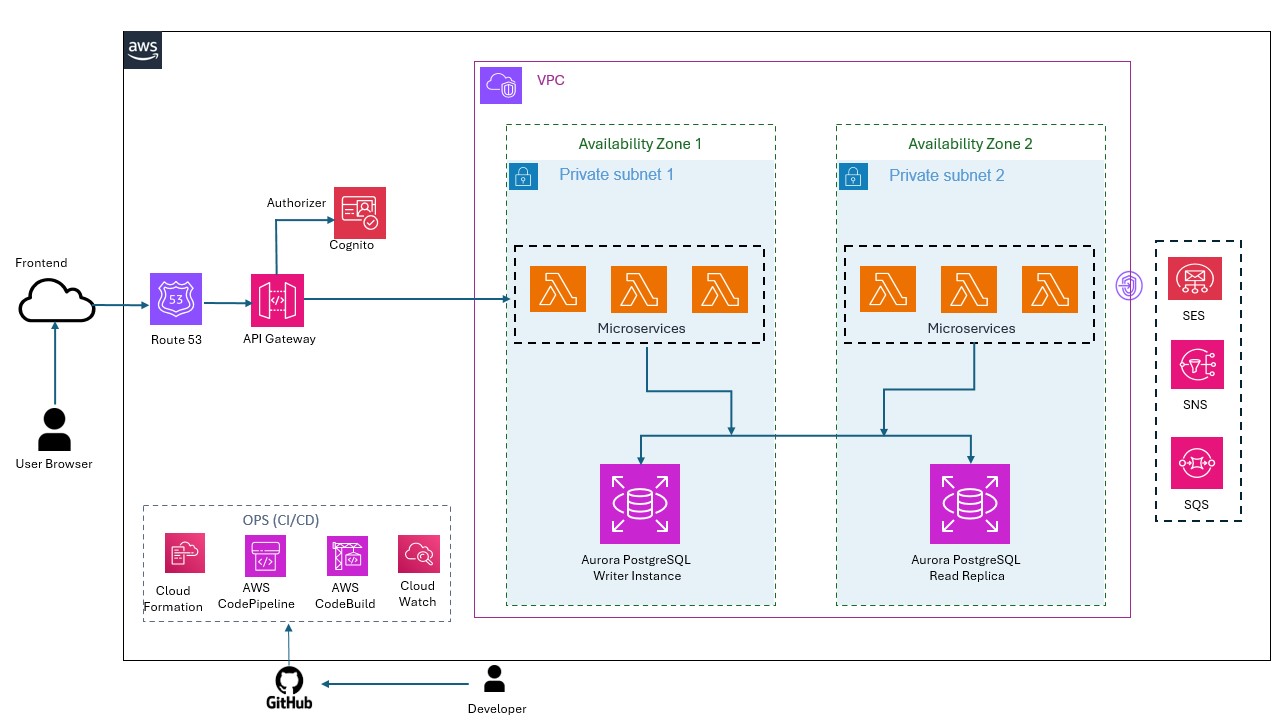Customer challenges
Our customer faced challenges modernizing their backend due to limitations of monolithic architecture, manual deployments, and lack of automation—leading to slow release cycles and unreliable recovery. Security concerns included weak session management and no centralized identity control, affecting auditing and compliance. Their infrastructure lacked redundancy and scalability, causing outages and poor performance under load. The absence of integrated monitoring further reduced visibility, while non-event-driven systems struggled with background tasks and real-time operations.
Solutions
To overcome these challenges, a fully serverless, event-driven architecture was adopted using scalable AWS services combined with modern DevOps practices. At the core of this solution is an automated CI/CD pipeline leveraging GitHub for version control, AWS CodePipeline for orchestrating deployments, AWS CodeBuild for compiling and testing code, and AWS CloudFormation for consistent infrastructure provisioning through Infrastructure-as-Code (IaC). This approach ensures that every code change is automatically validated, tested, and deployed, reducing manual dependencies and increasing delivery speed and consistency.
The application backend was modularized into stateless microservices deployed as AWS Lambda functions. These functions reside within private subnets across multiple Availability Zones, enabling fault-tolerant, secure, and highly available compute without the need for managing traditional servers. The microservices are horizontally scalable and can dynamically adjust to workload demands.
Authentication and access management were centralized using Amazon Cognito, which integrates natively with API Gateway and Lambda Authorizer to enforce secure, token-based access control. This offloads the complexity of user identity management and ensures compliance with security best practices.
A high-performance data layer was implemented using Amazon Aurora PostgreSQL. Database operations are optimized by routing write operations to a dedicated writer instance while offloading read-intensive workloads to one or more read replicas. This setup boosts performance, ensures high availability, and facilitates seamless failover and maintenance.
To support decoupled communication and asynchronous workloads, the architecture integrates Amazon Simple Notification Service (SNS), Amazon Simple Email Service (SES), and Amazon Simple Queue Service (SQS). These services allow for scalable messaging, email alerts, and job queuing without tightly coupling system components.
For observability, Amazon CloudWatch provides centralized logging, performance metrics, and alerting. This enables real-time insights into application behavior, build processes, and API usage, empowering teams to detect issues early and take corrective actions proactively.

AWS services used
Results
The solution transformed the customer’s architecture with tangible benefits:
Fully automated CI/CD pipeline using GitHub, CodePipeline, and CodeBuild.
Zero manual intervention for deployment and infrastructure provisioning.
Scalable and highly available backend using multi-AZ Lambda deployments.
Secure and controlled user authentication using Amazon Cognito.
Improved fault tolerance and high availability via private subnets across AZs
Asynchronous communication achieved using SES (emails), SNS (notifications), and SQS (queues).
Comprehensive logging and alerting via Amazon CloudWatch.
Infrastructure-as-Code ensured consistent environment provisioning using CloudFormation.

